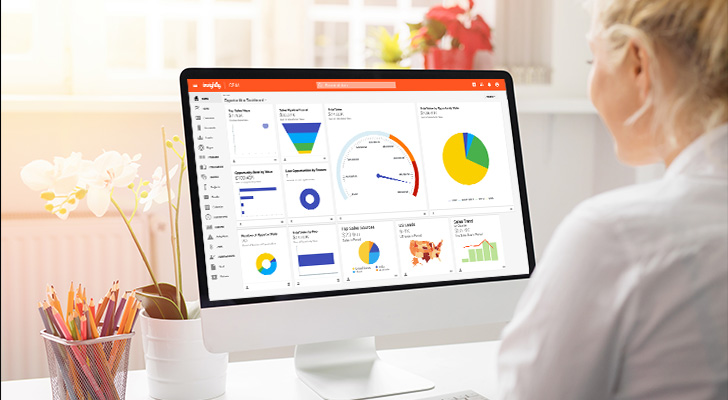Customer Relationship Management (CRM) integration is essential to unlocking the true power of a CRM. Integrations add functionality to CRMs and build a reliable source of truth you can count on to make decisions across your entire organization by connecting every single application you use to run your business.
When done right, CRM integrations reduce organizational silos, save time, and bring an in-depth customer understanding to your entire organization.
This clarity is where the CRM magic happens.
What are CRM integrations?
CRM integrations connect your customer relationship management system to external business tools so data flows automatically between platforms. This means your sales, marketing, and accounting software all share the same customer information instead of operating in isolation. When someone updates a contact in your marketing platform, that change appears instantly in your CRM, and vice versa.
Think about it this way:
Most businesses juggle dozens of different tools. Your team probably uses one app for email marketing, another for project management, and yet another for invoicing. Without integrations, each tool holds pieces of the customer puzzle, but nobody sees the complete picture.
CRM integrations create an accurate, comprehensive view of your customers and prospects. They improve how you communicate with customers and deliver more value from every interaction.
Why integrate your CRM with other tools?
CRM integrations eliminate the frustration of juggling multiple systems that don’t talk to each other. When your tools work together automatically, your teams spend less time on admin work and more time actually helping customers.
Here’s what changes when you connect everything:
- Your teams get better at serving customers. Real-time data sharing means everyone has the latest customer information at their fingertips. No more putting people on hold while you hunt through different systems for their order history.
- Manual work becomes a thing of the past. Copy-pasting contact details between apps? Done. Updating the same information in five different places? Also done. Integrations handle the busy work so your people can focus on what actually matters.
- Your reports actually make sense. When data flows between all your systems, you get a complete picture of what’s working and what isn’t. No more guessing whether that marketing campaign really drove sales—the numbers connect automatically.
The ripple effects go even further:
You’ll see faster deal cycles because nothing falls through the cracks. Customer relationships improve because everyone knows the full story. And your team? They’ll actually enjoy using your tools instead of fighting with them all day.
Bottom line?
Integrated systems turn your CRM from a glorified contact list into the command center that actually runs your business.
How to integrate your CRM with the rest of your tech stack
Convinced that integrating your CRM is the right move? Good news—it doesn’t have to be expensive or take forever.
The approach you choose depends on your CRM and how comfortable you are with technical setup.
Approach #1: Native integrations inside your CRM (ideal)
This is the gold standard—your CRM comes with built-in connections to popular tools. No third-party middleman, no extra fees, no headaches.
If you’re working with a unified CRM like Insightly, this is where things get exciting. Insightly’s AppConnect is a no-code integration engine that lets you connect hundreds of applications directly to your CRM.
The best part? You don’t need to be a software engineer to build these connections. The interface is intuitive enough that ops teams can set up sophisticated workflows between Insightly and tools like Slack, NetSuite, QuickBooks, or any of hundreds of other platforms.
Approach #2: The low-code method with third party connectors
Can’t find a native integration for the tool you need? This is where connector platforms like Zapier and Make.com come in handy. They act as the middleman between your CRM and other apps, creating automated workflows without requiring developer support.
- The upside: You can connect almost anything to anything.
- The trade-off: You’re adding another layer to your tech stack, which means another monthly subscription and another potential point of failure.
Still, this approach works well for most teams and keeps you moving without waiting for your IT department.
Approach #3: Custom integrations using APIs
Here’s where things get a bit more technical.
API integrations give you complete control over how your systems talk to each other. If your CRM offers robust API access (and if it doesn’t, might be time to switch to one that does), you can build custom connections that do exactly what you need.
This probably won’t be your first choice unless you have development resources and very specific requirements. But when you need something that doesn’t exist as a pre-built integration? API access means the world is your oyster.
The 4 must-have CRM integrations for functional teams
Now you know that CRM integrations allow your team to maximize and optimize tasks and perform their jobs more effectively. The more you can integrate CRM technology with your teams and their workflows, the better you’ll be able to focus on what counts — your customers’ experience and their goals.
You likely want all of the integrations right now, but how do you decide which to prioritize? Talk with your teams to discover and understand their frequent and high visibility needs to gain momentum when kicking off enhancement projects. This approach will simplify processes and provide a clear roadmap to help you determine and prioritize what integrations will deliver the best ROI and limit scope creep during the building sessions. The good news is that Insightly AppConnect is so easy to use, that you can tackle many integrations right away.
1. Sales and marketing tools
When marketing and sales are in sync, the odds of success dramatically increase. Teams can elevate and strengthen marketing and sales impact by integrating a number of applications to help support and enhance collaboration. Some examples include:
- Send landing page leads straight to Insightly CRM using the native Unbounce integration, so your sales team can follow up while interest is still high. Trigger follow-ups, assign leads, and run workflows automatically so nothing stalls out.
- Keep lines of communication open with the Slack connector. Celebrate victories with closed-won deals auto-populating to a “wins” channel. Receive alerts to approve deals or when prospects are hot and ready for a call.
- Rather than going back and forth between systems, trigger quotes and invoices via an integration with Quickbooks online, access your online store using a Shopify integration, or trigger DocuSign to get the deal sign-off now.
- Generate roll-up reports on campaign effectiveness without switching apps when you integrate with your ERP (e.g. NetSuite).
- Leverage communications tools by integrating with Gong and SalesLoft to get insights into lead qualification.
These are just a few examples of the benefits of enhancing your sales and marketing collaboration; in fact, there are hundreds of sales and marketing applications you could use to create velocity through the sales and marketing process.
Examples of sales and marketing tools to integrate
- Gong: Get conversation insights directly in your pipeline view
- Unbounce: Send your landing page leads straight to your CRM.
- ZoomInfo: Enrich lead records with contact data automatically
- Calendly: Book meetings that create deals instantly
- Drift: Turn chat conversations into qualified opportunities
2. Finance and accounting tools
Empowering your team by integrating their SAP, Quickbooks, and DocuSign processes into a CRM can free them from unproductive platform toggling. They can automate the entire end-to-end process and securely sync and store vital vendor and organizational data, too.
Frequently used requests or processes (payment, invoicing, ordering, quoting, etc.) can be triggered and routed automatically to and from platforms like SAP and Quickbooks that record each step’s signing-off (DocuSign) status and history. CRM integrations also allow you to make sure all needed and required compliance documents are automatically uploaded and organized proactively, so you don’t have to put in the effort to meet regulatory filing and audit checkpoints.
Using integrated dashboards, you will never be far away from reporting status. All your spend and revenue data is ready and at your fingertips to provide critical insights and empower agile business decisions in real-time.
Examples of finance and accounting tools to integrate
- NetSuite: Keep your ERP and CRM talking to each other
- Xero: Sync customer data between accounting and sales systems
- Sage Intacct: Connect financial reporting with sales performance
3. Human resources tools
Hiring great talent can be a challenge. With integrations to Talent Management platforms like Greenhouse, you can automate referrals and recruitment processes like scheduling interviews, and manage interview feedback communications effortlessly.
Enhanced integrations can also help save HR staff time by keeping job descriptions up-to-date, improving resume scoring, and surfacing better candidate choices, all while syncing it with your HR solutions and platforms.
It can take a considerable amount of time to hire someone, and you want to get them onboarded and productive as fast as possible. Integrating apps like BambooHR, Workday, and OKTA can automate onboarding and offboarding sequences for account generation or deletion, and grant permissions, benefits selection, and HR-based equipment provisioning.
Examples of HR tools to integrate
- BambooHR: Automate onboarding workflows for new hires
- Workday: Keep employee data synced across business systems
- Okta: Manage user access and permissions automatically
- ADP: Connect payroll data with project staffing costs
4. IT and operations tools
Any downtime means a loss to the bottom line. IT integrations can help detect problems and proactively initiate incident resolution processes.
Integrating your CRM with platforms like ServiceNow can automate and prioritize incident ticket generation, which will help decrease resolution times. Users can stay up to date with real-time communications via chatbots and collaboration tools like Slack. This can serve to communicate status in areas like ticket escalation, ticket assignments, and incident alerts.
Help Desk staff can also access best-practice knowledge libraries from multiple systems, so they have one source of truth when researching solutions.
Examples of IT and operations tools to integrate
- Slack: Get real-time deal alerts and celebrate wins instantly
- ServiceNow: Connect customer issues with account history
- Jira: Track development work tied to specific customer requests
- Asana: Convert closed deals into delivery project workflows
Get started with Insightly (an integrated CRM)
Your business is about more than just transactions. It’s about building customer relationships that make your clients feel valued and confident about their purchases.
You already know how important it is to have all your customer knowledge in one place. When your team can instantly access reliable, up-to-date information, everything else gets easier.
That’s where Insightly’s CRM shines.
We’ve built a platform that connects everything you use to run your business. No more jumping between tools or hunting through spreadsheets for customer information.
- Native integrations through AppConnect: Connect hundreds of apps without developers or long implementation cycles
- Unified customer view: Sales, marketing, and service all work from the same customer data
- No-code customization: Adapt workflows and fields to match how your team actually works
Want to see how it all works together for your specific business? Request a demo and discover how integrated systems can transform your team’s productivity.
Common questions on CRM integrations
We’ve covered the big picture of CRM integrations and why they matter, but you may still have some specific questions about how this all works in practice. Consider these a few of the questions we hear most from teams getting ready to connect their tools.
What is the purpose of integrating a CRM with other tools?
CRM integrations connect your customer relationship management system to external business tools to sync data automatically. This means your sales, marketing, and support teams work with the same up-to-date customer information instead of juggling separate systems. Companies typically connect their CRMs with email platforms, accounting software, or project management tools to create one unified view of each customer relationship.
How do I choose the right CRM integrations for my business?
Start by identifying where your teams waste the most time on repetitive tasks or duplicate data entry. Focus on integrations that directly support your biggest revenue goals—like connecting marketing automation for lead nurturing or accounting systems for faster invoicing. Insightly’s AppConnect also offers hundreds of pre-built connections, so you can link existing tools without needing developers or complex CRM implementation projects.
Can CRM integrations help reduce manual work?
CRM integrations reduce manual work by connecting your existing business tools so data flows between them automatically. This eliminates the need to copy and paste contact information between systems, export data to spreadsheets for analysis, or jump between multiple applications to complete basic tasks.
When your CRM connects your email marketing, accounting, and project management tools together under one roof, you can work from one central location instead of jumping between platforms all day.
What are common challenges when setting up CRM integrations?
Most integration problems stem from rushing the setup process without proper planning. This leads to plenty of common (and easily avoidable) issues like:
- Data duplication when sync rules aren’t clearly defined
- Connection errors between incompatible systems
- Overly complex workflows that break easily
- Poor user adoption when integrations don’t match real workflows
The ideal solution is starting with a clear integration strategy, testing everything in a safe environment first, and involving end users in the integration implementation process.
How do CRM integrations support better reporting and analytics?
CRM integrations improve reporting by pulling data from multiple business systems into one central location. This helps to eliminate data silos and lets any team access data that would otherwise be buried in third party applications they can’t even log in to. Plus, with the right data integrations in place you can create comprehensive reports that combine sales performance, marketing campaign results, and customer service metrics in real-time.
When integrations work properly, you get complete visibility into your customer journey and can make more accurate forecasts—which makes tracking the right CRM metrics even more valuable.



